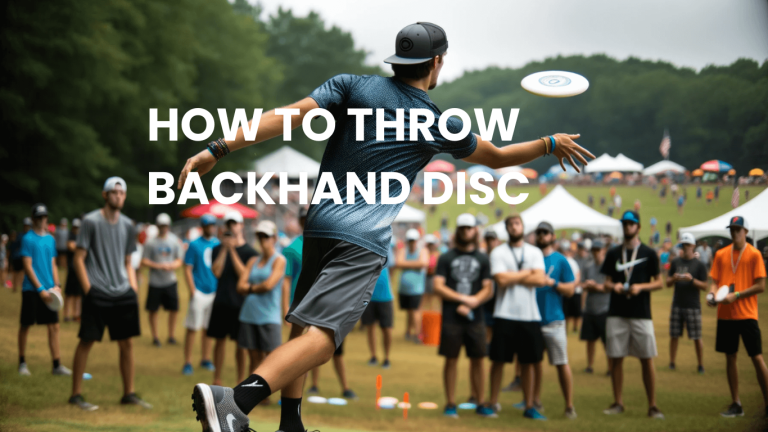How to throw disc golf flatter? Essential Tips for Disc Golf Enthusiasts
Unlock the secrets to a flatter disc golf throw with expert tips and techniques in our comprehensive guide. Throwing a disc golf disc flatter is a game-changer, and I learned this the hard way. In my early days, my throws often veered off course, leaving me frustrated. I remember watching seasoned players, marveling at how their discs flew straight and true. Determined to improve, I dove into understanding the technique behind a flat throw.
It was not just about power; it was about finesse and understanding the physics of the disc. Through trial and error, I discovered that a flatter throw could mean the difference between a decent round and a great one. This journey of mastering the flat throw in disc golf has been both challenging and rewarding. And now, I’m here to share these insights with you, so you can enhance your game too.
How to throw disc golf flatter?
Mastering the flat throw in disc golf didn’t come easy to me. Every misdirected disc was a lesson in the importance of technique. I recall the frustration of watching my disc veer off, far from where I aimed. It dawned on me that power alone wasn’t the answer; precision played a crucial role. By studying the flight patterns and adjusting my approach, I started to see a transformation in my game. Achieving a flatter throw became my obsession, and gradually, it transformed my gameplay. In this journey, I learned that a flatter throw is essential for any disc golfer looking to up their game.
Let me share the secrets I’ve uncovered to help you throw your disc golf disc flatter and more effectively.
Introduction to Disc Golf and the Flat Throw
I remember the first time I picked up a disc golf disc. The game seemed simple enough: throw the disc, aim for the basket, and try to get the lowest score. But as I delved deeper, I realized there’s more to it, especially when it comes to mastering the flat throw. In disc golf, the way you throw can make a huge difference in your game. A flat throw, which means the disc travels in a straight line at a consistent altitude, is crucial for accuracy and distance.
It’s a skill that can turn a beginner into a more proficient player. I’ve spent countless hours on courses, learning and honing this technique. The benefits of mastering a flat throw are clear: better control, increased distance, and a lower score.
The Journey to Mastering the Flat Throw
My journey to mastering the flat throw in disc golf was filled with trial and error. I remember my initial throws; they were erratic and unpredictable. I quickly learned that the angle of release, the disc selection, and the power behind the throw all played pivotal roles. Through practice, I began to understand the mechanics of a flat throw. The grip, the stance, the wind-up, and the release – each component was critical.
As I improved, my throws became more consistent. The satisfaction of seeing the disc glide smoothly towards the basket was unmatched. This technique isn’t just about power; it’s about precision and understanding the aerodynamics of the disc. Every throw became a learning experience, pushing me to refine my skills further.
Sharing the Insights
Now, as someone who has spent considerable time on the disc golf course, I want to share these insights with you. Throwing a disc golf disc flatter isn’t just about physical strength; it’s about understanding the physics and adapting your technique. It’s about choosing the right disc for the conditions and your playing style. It’s about the little adjustments in grip and stance that make a big difference. And above all, it’s about patience and practice. Whether you’re a beginner or looking to improve your game, mastering the flat throw is a valuable skill in your disc golf arsenal. It’s a skill that not only improves your game but also increases your enjoyment of this wonderful sport.
Grasping the Fundamentals of Disc Golf
When I first started playing disc golf, I was struck by its simplicity and depth. Disc golf, at its core, is about throwing a disc towards a target, usually a basket, with the goal of completing each hole in the fewest throws possible. Each course, with varied terrains and obstacles, presents unique challenges. I quickly learned that understanding the basic rules and objectives was crucial. It’s not just about throwing the disc; it’s about strategy, precision, and adapting to the environment. As I played more, I realized that disc golf was a blend of skill, physical exertion, and mental strategy – a combination that made each game both challenging and rewarding.
Diversity in Throwing Techniques
As my journey in disc golf continued, I discovered the diversity in throwing techniques. There’s not just one way to throw a disc. From the backhand to the forehand, from the hyzer to the anhyzer, each technique has its unique mechanics and uses. I experimented with different throws, realizing that each situation on the course might require a different approach. The backhand throw became my go-to for power and distance, while the forehand offered more control and accuracy in tight spots. Understanding these techniques and knowing when to use them added a strategic layer to my game that was both fascinating and complex.

The Role of Technique in Disc Golf
As I delved deeper into the world of disc golf, I began to appreciate the role of technique in improving one’s game. It’s not just about throwing the disc as hard as you can; it’s about understanding the flight patterns, adjusting your grip and stance, and choosing the right disc for the right situation. Mastering different throwing techniques not only improved my performance but also enhanced my enjoyment of the game. Disc golf is a sport where continuous learning and practice play a significant role. Whether it’s a casual round with friends or a competitive tournament, the techniques you employ can greatly influence your success on the course.
Deciphering the Disc Angle in Flight
When I first tried to master the flat throw in disc golf, I was baffled by how the disc’s angle affected its flight. It was a game of physics, and I was determined to crack it. The angle at which the disc is released – known as the angle of attack – plays a pivotal role in how the disc behaves in the air. A disc thrown flat tends to travel straighter and longer. In contrast, if you release the disc with a tilt, it curves, affecting accuracy and distance. I spent hours on the field, adjusting my release angle, observing how slight changes dramatically altered the disc’s flight path. This experimentation was key to understanding the subtle art of throwing flat.

Focus on a Flat-release Angle
Focusing on a flat release angle in disc golf has been a game-changer for me. It’s about precision: holding the disc level and releasing it parallel to the ground. This technique ensures a straighter flight and greater accuracy. I’ve spent hours practicing this, and the improvement in my throws is noticeable. It’s a simple yet effective tweak with significant impact.
You May Also Like to See: How To Throw a Disc Golf Putter?

Unveiling the Aerodynamics Behind Disc Golf Throws
My fascination with the science of aerodynamics in disc golf has been a game-changer. Delving into how various factors like the disc’s shape, weight, and design influence its interaction with air has been enlightening. I’ve learned that discs with rounded edges offer a balance of lift and control, whereas those with sharper edges excel in speed and distance. This knowledge has revolutionized my approach to selecting discs, especially for flat throws. It’s not merely about the force applied; it’s understanding the intricate dance between the disc and the air currents. This insight has elevated my throws from mere attempts to strategically calculated flights.
Mastering the Art of the Flat Throw in Disc Golf
Embarking on the journey to refine my flat throw technique in disc golf has been both challenging and rewarding. I realized the importance of consistency in grip, stance, and release. Mastering the flat throw isn’t just about hurling the disc; it’s about achieving a harmonious synergy between my movements for a balanced and controlled launch. Through relentless practice, I focused on maintaining a consistent angle, striving for the disc to leave my hand as flat as possible. Each throw brought me closer to perfection, enhancing my accuracy and reach. This journey in the world of disc golf has taught me that it’s more than just a sport; it’s a blend of scientific understanding and skillful execution, offering limitless potential for improvement and expertise.
Selecting the Ideal Disc for Flat Throws
Choosing the right disc for a flat throw in disc golf was a revelation for me. Each disc has unique flight characteristics, influenced by its shape, weight, and design. For flat throws, I prefer discs with a moderate rim width and balanced weight, as they offer a blend of control and distance. I’ve experimented with various types and found that stable to slightly overstable discs work best for maintaining a straight flight path. They resist wind better and provide the consistency needed for flat throws. This discovery was a turning point, enhancing my game significantly.
Drivers vs Approach Discs
In disc golf, drivers and approach discs serve distinct roles. Drivers, designed for distance, slice through the air for long-range throws. Approach discs, on the other hand, offer more control and precision, ideal for shorter and more accurate shots. Knowing when to use each type is key to a strategic game.
Mastering Grip Techniques
The way I grip the disc profoundly affects my throw. I learned that a firm yet relaxed grip is key. For backhand throws, the four-finger grip, with fingers tightly under the disc and the thumb on top, provides control and power. I practice ensuring my grip is consistent, as even minor variations can alter the disc’s flight. It’s fascinating how such a small detail, like how you hold the disc, can have such a big impact on your game.
Achieving the Right Stance
A proper stance is crucial for a powerful and accurate flat throw in disc golf. I focus on a stance that balances my body weight, allowing for a smooth transition of power from my legs through my torso to my arm. My feet are shoulder-width apart, with my lead foot slightly ahead, offering stability and agility. This stance forms the foundation of my throw, enabling me to channel power efficiently while maintaining control. It took practice, but getting this right made a noticeable difference in my throws.

Perfecting the Throwing Motion for Flat Throws
Mastering the flat throw in disc golf is all about the right throwing motion. I learned this through persistent practice. The key is a smooth, controlled motion where you lead with your shoulder and follow through with your arm and wrist. Keeping the disc level throughout the throw is crucial. At first, I struggled with tilting the disc up or down, which led to inconsistent throws. The breakthrough came when I focused on a flat release, imagining a straight line extending from my arm. This visual helped me maintain the disc’s angle, leading to much straighter and more predictable throws.
Avoiding Common Mistakes
One common mistake I noticed in my early days was rounding – where the arm follows a circular path, leading to less accurate throws. I worked on a straighter arm path, ensuring my movement was parallel to the ground. Another error was inconsistent footwork, which I corrected by practicing a steady x-step, aligning my feet with the target. This not only improved my accuracy but also increased my throw’s distance. Recognizing and correcting these mistakes was a significant step in enhancing my flat throw technique.
Drills and Tips
To further refine my flat throws, I incorporated drills recommended by professional disc golf players. One effective drill is the towel snap exercise, where you mimic the throwing motion with a towel to focus on wrist action and speed. Another is field practice, where you throw at varying distances to gain control over your power and angle. Professionals emphasize the importance of repetition and muscle memory in mastering the flat throw. Their insights have been invaluable, transforming my throws from amateur to much more consistent and controlled.
Cultivating a Disc Golf Mindset for Better Throws
In my journey of playing disc golf, I realized the mental approach is as important as the physical technique. Developing a positive mindset, focusing on each throw and learning from every miss, has been crucial. I adopt a mentality that embraces practice and persistence, knowing that every throw is an opportunity to improve. This mindset not only helps in mastering flat throws but also boosts overall confidence on the course. It’s about staying calm, being patient, and keeping a clear head, especially under pressure. Embracing this mental approach has significantly enhanced my game.
Strategizing with Flat Throws
Incorporating flat throws into my game strategy has been a game-changer. I use flat throws for long, open fairways where accuracy and distance are key. Understanding when and how to use this throw strategically has helped me navigate courses more effectively. It’s about reading the course, assessing the conditions, and choosing the throw that gives you the best chance of a low score. This strategic use of flat throws, combined with other techniques, creates a versatile and adaptable approach to each game, making me a more formidable player on the course.
Overcoming Challenges
Perfecting the flat throw in disc golf comes with its set of challenges. Initially, I struggled with maintaining a consistent release angle and dealing with variable wind conditions. I learned to make slight adjustments in my grip and stance based on the wind direction and speed. Identifying these issues and adapting my technique was key to overcoming these challenges. Regular practice and analyzing each throw helped me refine my skills. Now, I face these challenges with confidence, knowing that I have the skills and knowledge to adjust and improve continuously.
You May Also Like To See: How To Dye Disc Golf Disc?
Adapting Throws in Varied Disc Golf Conditions
Playing disc golf in diverse conditions taught me the importance of adapting my throws. Windy conditions demand a more stable disc and a lower, flatter throw to counteract the wind’s unpredictability. Varied terrains, like hilly courses, require a strategic approach to elevation changes. I’ve learned to adjust my throwing angle and power depending on whether I’m throwing uphill or downhill. These adaptations not only improved my game but also made me a more versatile player. Disc golf isn’t just played in perfect conditions; it’s about adapting to whatever the course throws at you.
Embracing Technology
Incorporating technology into my disc golf practice has been transformative. I use apps that analyze my throwing technique, showing me the speed, angle, and distance of each throw. These insights have been invaluable in tweaking my technique for better results. Wearable technology, like smartwatches, also helps me track my physical performance on the course. This integration of technology into my practice routine has given me a deeper understanding of my throws and how to improve them, making the learning process more efficient and effective.
Impact of the Disc Golf Community
Joining the disc golf community has significantly contributed to my skill development. Local clubs and online forums offer a wealth of knowledge and support. I’ve picked up countless tips from more experienced players and have had the chance to share my own insights with beginners. The community aspect of disc golf is incredibly supportive, with players always willing to help each other out. This interaction has not only improved my skills but also deepened my love for the sport. Being part of a community that shares your passion is both motivating and rewarding.
Conclusion
Mastering how to throw a disc golf disc flatter has been a rewarding journey filled with learning and growth. From understanding the mechanics to adapting to various conditions, each aspect has honed my skills and deepened my love for the game.
Disc golf is more than a sport; it’s a journey of continuous improvement and enjoyment.
FAQs
Q1: Why does my disc golf disc keep turning left when I try a flat throw?
Answer:
It’s likely due to the release angle. Try releasing the disc perfectly level to ensure a straighter flight.
Q2: How can I increase distance while maintaining a flat throw in disc golf?
Answer:
Focus on a smoother follow-through and a firmer grip to enhance both distance and flatness of the throw.
Q3: What’s the best way to practice flat throws for disc golf in windy conditions?
Answer:
Practice with a more stable disc in mild wind to get a feel for how the wind affects the disc’s flight path.







